March, 1932
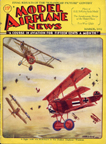
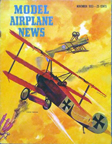
Manfred Von Richthofen and the Fokker Dr. 1 "Dreidecker"
Model Airplane News Cover Art for March, 1932 and November, 1953
by Jo Kotula
Click to Enlarge
This month's cover concerns both the Fokker Dr. 1 "Dreidecker" (Triplane) but also its most noted pilot, Manfred Von Richthofen, the "Red Baron who had 80 confirmed victories. This review shall discuss both - first, the Baron and second, the Triplane.
Manfred Albrecht Freiherr von Richthofen (2 May 1892 – 21 April 1918) was a German fighter pilot known as the "Red Baron". He was the most successful flying ace during World War I, being officially credited with 80 confirmed air combat victories. He served in the Imperial German Army Air Service (Luftstreitkräfte). Richthofen was a member of an aristocratic family with many famous relatives including his brother Lothar who was also an Ace, with 40 victories.
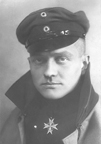
Manfred Von Richthofen
Click to Enlarge
Freiherr (literally "Free Lord") is not a given name but a German aristocratic title, equivalent to a baron in other countries and the origin of Richthofen's most famous nickname: "The Red Baron". Red was the colour of his plane. The German translation of Red Baron. Richthofen is today known by this nickname even in Germany, although during his lifetime he was more often described in German as Der Rote Kampfflieger, (variously translated as the The Red Battle Flyer or The Red Fighter Pilot). This name was used as the title of Richthofen's 1917 "autobiography." Richthofen's other nicknames include "Le Diable Rouge" ("Red Devil") or "Le Petit Rouge" ("Little Red") in French, and the "Red Knight" in English.
When World War I began, Richthofen served as an uhlan or cavalry reconnaissance officer on both the Eastern and Western Fronts. Traditional cavalry operations soon became impossible due to machine guns and barbed wire, and the Uhlans were used as infantry.[8] Disappointed at not being able to participate more often in combat, Richthofen applied for a transfer to Die Fliegertruppen des deutschen Kaiserreiches (Imperial German Army Air Service), later to be known as the Luftstreitkräfte. His request was granted and he joined the flying service at the end of May 1915.
From June to August 1915, Richthofen was an observer on reconnaissance missions over the Eastern Front with Fliegerabteilung 69 ("No. 69 Flying Squadron"). On being transferred to the Champagne front, he managed to shoot down an attacking French Farman aircraft with his observer's machine gun, but was not credited with the kill, since it fell behind Allied lines and could not be confirmed. He entered training as a pilot in October 1915. In March 1916, he joined Kampfgeschwader 2 ("No. 2 Bomber Geschwader") flying a two-seater Albatros C.III. Over Verdun on 26 April 1916, he fired on a French Nieuport, downing it over Fort Douaumont, though once again he received no official credit. By now, he was flying a Fokker Eindecker single-seater fighter. After another spell flying two-seaters on the Eastern Front, he met ace fighter pilot Oswald Boelcke in August 1916. Boelcke, visiting the east in search of candidates for his newly-formed fighter unit, selected Richthofen to join Jagdstaffel 2 ("fighter squadron"). Richthofen won his first aerial combat with Jasta 2 over Cambrai, France, on 17 September 1916.
After his 16th confirmed kill, Richthofen received the Pour le Mérite ("The Blue Max"), the highest military honour in Germany at the time. That same month, he assumed command of Jasta 11, which ultimately included some of the elite German pilots, many of whom he trained himself. SAs a practical aid to easy identification in the melee of air combat, Jasta 11's aircraft soon adopted red colourations with various individual markings, with some of Richthofen's own aircraft painted entirely red. Richthofen was a brilliant tactician, building on Boelcke's tactics. But unlike Boelcke, he led by example and force of will rather than by inspiration.
Richthofen championed the development of the Fokker D.VII with suggestions to overcome the deficiencies of the then current German fighter aircraft.[2] However, he never had an opportunity to fly it in combat as he was killed just days before it entered service. Richthofen was shot down just after 11 a.m. on 21 April 1918, while flying over Morlancourt Ridge, near the Somme River.
Click Here for more information about the Manfred Von Richthofen.
The Fokker Dr. I "Dreidecker"
The Fokker Dr.I Dreidecker (triplane) was a World War I fighter aircraft built by Fokker-Flugzeugwerke. The Dr.I saw widespread service in the spring of 1918. It became renowned as the aircraft in which Manfred von Richthofen gained his last 20 victories, and in which he was killed on 21 April 1918.
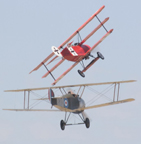
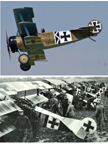
Fokker Dr. I "Dreidecker" (Triplane)
Click to Enlarge
In February 1917, the Sopwith Triplane began to appear over the Western Front anf swiftly proved itself superior to the Albatross fighters then in use by the Luftstreitkräfte (German Air Force). The Fokker-Flugzeugwerke (Fokker Airplane Factory) responded by converting an unfinished biplane prototype into a "V.4", a small, rotary-powered triplane with a steel tube fuselage and thick cantilever wings. Initial tests revealed that the V.4 had unacceptably high control forces resulting from the use of unbalanced ailerons and elevators. Learning from this, Fokker produced V.5. The most notable changes intorducing new control surfaces and longer-span wings with interplane struts to minimize wing flexing. On 14 July 1917, the aircraft went into production.
Here is a video of the Fokker Dr. I "Dreidecker" (Triplane) in action:
Click Here to learn about the Fokker Dr. I "Dreidecker".
This continues to be a popular Cleveland kit due to the numerous references to the "Red Baron" that still abound in American popular culture.
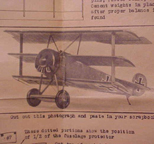
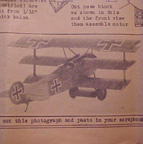


Cleveland Model of the Fokker Dr. I "Dreidecker"
In the old days, kids would keep scrapbooks...
(right)This is what a 1930s vintage box would look like
Click to Enlarge
You can buy the plans and patterns that will enable you to make this model right now. Click Here to go to the exact location on the Cleveland Website to get them.

Fokker Dr. I "Dreidecker" at the Cleveland Site
Click to Enlarge
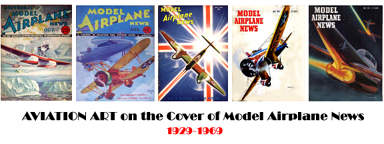
Click to go back and select another cover.
Counter for the Entire Site (not just this page..)
Home | About Lindy | Last Week's Reviews | Upcoming Events | 1940s Collecibles
The Guide - Establishments - Travel - Accessories
Music | Links | Photo Gallery | Extras | Contact